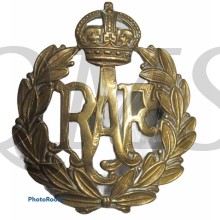Cap badge Royal Air Force RAF WW2
The Royal Air Force (RAF) is the United Kingdom's aerial warfare force. Formed towards the end of the First World War on 1 April 1918, it is the oldest independent air force in the world. Following victory over the Central Powers in 1918 the RAF emerged – at the time – the largest air force in the world. Since its formation, the RAF has taken a significant role in British military history, in particular, playing a large part in the Second World War where it fought its most famous campaign, the Battle of Britain.
The RAF's mission is to support the objectives of the British Ministry of Defence (MoD), which are to "provide the capabilities needed: to ensure the security and defence of the United Kingdom and overseas territories, including against terrorism; to support the Government’s foreign policy objectives particularly in promoting international peace and security." The RAF describe its mission statement as "... [to provide] An agile, adaptable and capable Air Force that, person for person, is second to none, and that makes a decisive air power contribution in support of the UK Defence Mission." The mission statement is supported by the RAF's definition of air power, which guides its strategy. Air power is defined as: "The ability to project power from the air and space to influence the behaviour of people or the course of events."
Today the Royal Air Force maintains an operational fleet of various types of aircraft, described by the RAF as being "leading-edge" in terms of technology.[This largely consists of fixed-wing aircraft, including: fighter and strike aircraft, airborne early warning and control aircraft, ISTAR and SIGINT aircraft, aerial refuelingaircraft and strategic and tactical transport aircraft. The majority of the RAF's rotary-wing aircraft form part of the tri-service Joint Helicopter Command in support of ground forces. Most of the RAF's aircraft and personnel are based in the UK, with many others serving on operations (principally Afghanistan) or at long-established overseas bases (Ascension Island, Cyprus, Gibraltar, and the Falkland Islands). Although the RAF is the principal British air power arm, the Royal Navy's Fleet Air Arm and the British Army's Army Air Corps also deliver air power which is integrated into the maritime, littoral and land environments.
The RAF underwent rapid expansion prior to and during the Second World War. Under the British Commonwealth Air Training Plan of December 1939, the air forces of British Commonwealth countries trained and formed "Article XV squadrons" for service with RAF formations. Many individual personnel from these countries, and exiles from occupied Europe, also served with RAF squadrons. By the end of the war the Royal Canadian Air Force had contributed more than 30 squadrons to serve in RAF formations, similarly, approximately a quarter of Bomber Command's personnel were Canadian. Additionally, the Royal Australian Air Force represented around nine percent of all RAF personnel who served in the European and Mediterranean theaters.
In the Battle of Britain in 1940, the RAF (supplemented by 2 Fleet Air Arm Squadrons, Polish, Czecho-Slovak and other multinational pilots and ground personnel) defended the skies over Britain against the numerically superior German Luftwaffe. In what is perhaps the most prolonged and complicated air campaign in history, the Battle of Britain contributed significantly to the delay and subsequent indefinite postponement of Hitler's plans for an invasion of the United Kingdom (Operation Sealion). In the House of Commons on 20 August, prompted by the ongoing efforts of the RAF, Prime Minister Winston Churchill eloquently made a speech to the nation, where he said "Never in the field of human conflict was so much owed by so many to so few".
The largest RAF effort during the war was the strategic bombing campaign against Germany by Bomber Command. While RAF bombing of Germany began almost immediately upon the outbreak of war, under the leadership of Air Chief Marshal Harris, these attacks became increasingly devastating from 1942 onward as new technology and greater numbers of superior aircraft became available. The RAF adopted night-time area bombing on German cities such as Hamburg and Dresden, and developed precision bombing techniques for specific operations, such as the "Dambusters" raid by No. 617 Squadron, or the Amiens prison raid known as Operation Jericho.



